Reactive Streams and RxJava2
5 likes3,905 views
This document provides an overview of Reactive Streams and RxJava2. It discusses key concepts like asynchronous programming, backpressure, Observables, Operators, Schedulers, and parallel processing. Reactive programming allows for data to flow through streams and algorithms in a resilient and message-driven way while hiding threading complexity. RxJava2 implements the Reactive Streams specification and provides APIs like Observable and Flowable to build reactive applications that can handle failures and chain asynchronous operations.
1 of 55
Downloaded 59 times
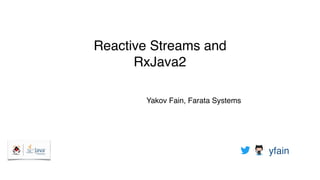



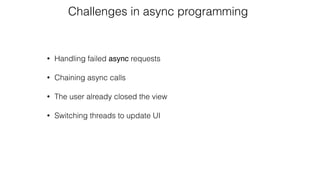


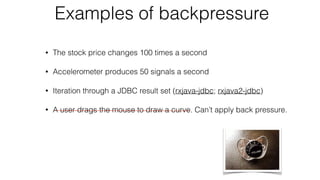
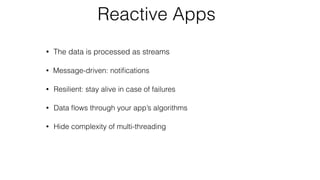
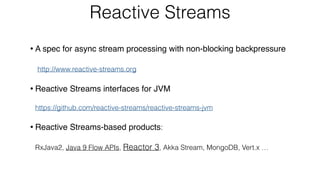
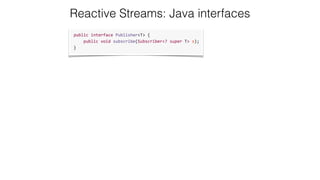

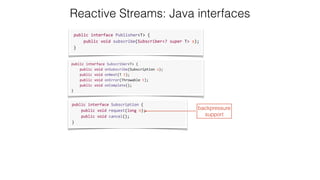
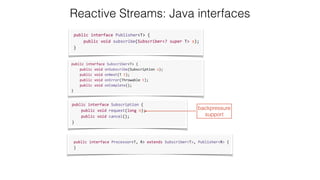

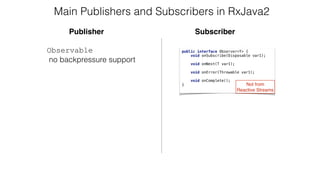
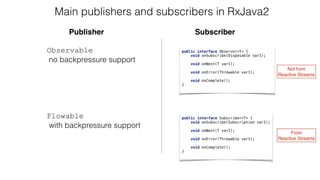
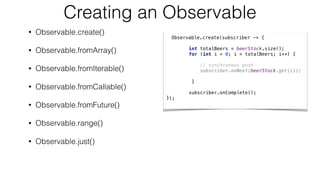
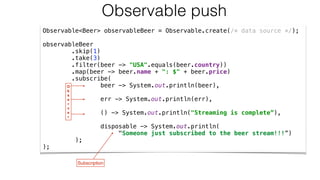

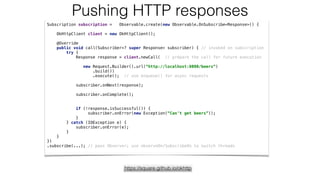
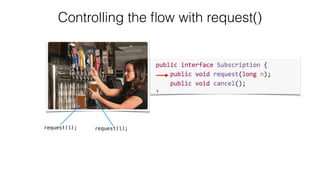

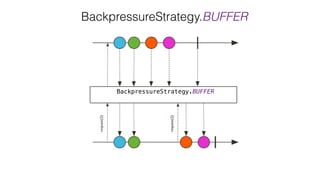



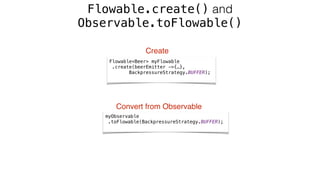
![Requesting data from Flowable
public class FlowableRange {
static DisposableSubscriber<Integer> subscriber;
public static void main(String[] args) {
subscriber = new DisposableSubscriber<Integer>() {
public void onStart() {
request(5);
while (true){ // Emulate 1-sec processing
try {
Thread.sleep(1000);
} catch (InterruptedException e) {
e.printStackTrace();
}
request(1);
}
}
public void onNext(Integer t) {
System.out.println("processing "+ t);
if (t==8) { // just to demo unsubscribing
subscriber.dispose();
}
}
public void onError(Throwable thr) {
System.err.println("In onError(): " + thr.getMessage());
}
public void onComplete() {
System.out.println("Done");
}
};
Flowable.range(1, 10)
.subscribe(subscriber);
}
}](https://image.slidesharecdn.com/rxjava216x9-170526092327/85/Reactive-Streams-and-RxJava2-29-320.jpg)
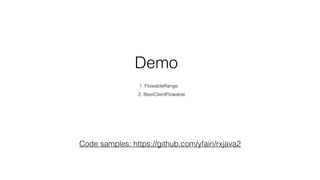
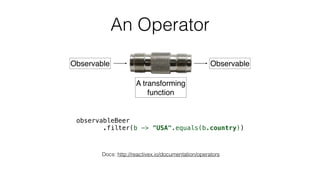


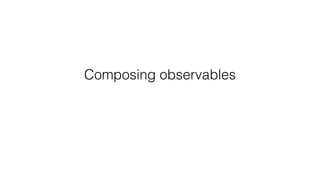

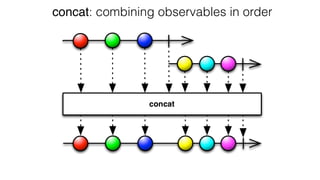
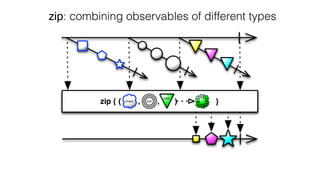
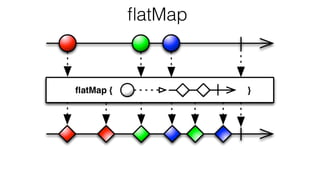

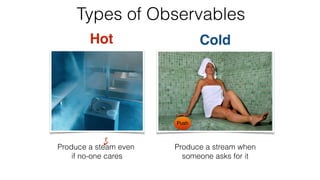
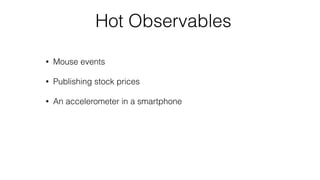

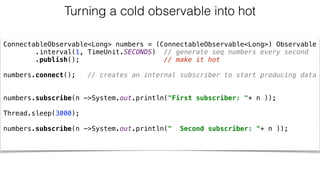



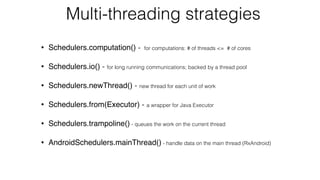
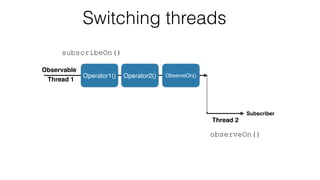
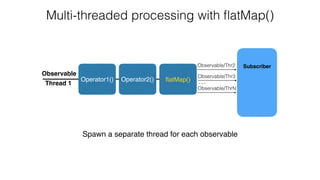
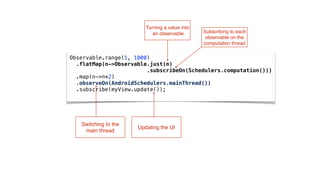


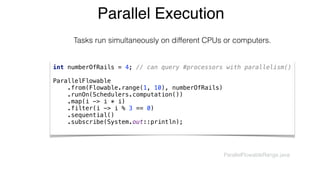
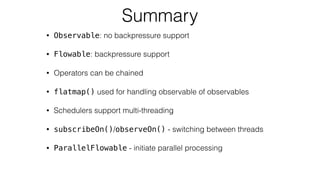

Ad
Recommended
Reactive programming in Angular 2
Reactive programming in Angular 2Yakov Fain This document discusses reactive programming in Angular 2 using RxJS. It introduces Observables and Observable operators like map, filter, and switchMap. It explains how to use Observables with HTTP requests, forms, and routing in Angular. Key concepts covered include creating Observables, subscribing to them, transforming streams with operators, and sharing Observables between subscribers.
Reactive Thinking in Java with RxJava2
Reactive Thinking in Java with RxJava2Yakov Fain Yakov Fain discusses reactive programming with RxJava2. He begins by describing the challenges of asynchronous and multi-threaded programming that reactive programming addresses. He then covers key RxJava2 concepts like Observables, Operators, Backpressure, and Schedulers. The document provides examples of creating Observables and Subscribers and using various operators to transform and compose Observable streams in a reactive and functional way.
Web sockets in Angular
Web sockets in AngularYakov Fain This document discusses WebSockets and their use in Angular applications. It contains the following information:
1. An introduction to WebSockets, including what they are, where server push is needed, and how to use them in plain JavaScript.
2. Two ways to use WebSockets in Angular - manually creating WebSocket objects or using RxJS WebSocketSubject.
3. A code example of a WebSocket service in Angular that wraps a WebSocket object and exposes it as an Observable stream.
Reactive Thinking in Java
Reactive Thinking in JavaYakov Fain The document discusses reactive programming concepts in Java using RxJava. It defines key RxJava terms like Observable, Observer, and Operator. It explains how RxJava uses asynchronous message passing with Observables that push data to Observer subscribers, unlike traditional Java APIs that use synchronous pulling of data. It provides examples of creating Observables and applying operators like map, filter, and flatMap. It also covers multi-threading in RxJava using schedulers, backpressure, and other advanced topics.
Intro to JavaScript
Intro to JavaScriptYakov Fain This document provides an overview of JavaScript concepts including:
- Where JavaScript can run including web browsers and JavaScript engines.
- Key differences from Java like JavaScript arriving as text with no compiler and need to work across runtime environments.
- Tools for debugging and developing JavaScript like Firefox's Firebug and Chrome Developer Tools.
- Variables, functions, objects, and inheritance in JavaScript compared to other languages like Java. Functions can be treated as first-class objects and assigned to properties or passed as callbacks.
Using JHipster for generating Angular/Spring Boot apps
Using JHipster for generating Angular/Spring Boot appsYakov Fain The document discusses using JHipster 4 for generating Angular and Spring Boot applications. It begins with an overview of Spring Boot and Angular and demonstrates generating a basic monolithic application with them. It then introduces JHipster as a tool for generating Angular/Spring Boot projects along with best practices. The rest of the document demonstrates features of JHipster like generating entities, internationalization, and microservices architecture.
Angular2 Development for Java developers
Angular2 Development for Java developersYakov Fain This document provides an overview of Angular 2 development for Java developers. It discusses key aspects of Angular 2 including components, templates, data binding, dependency injection, and routing. It also covers TypeScript and how it adds types, classes and interfaces to JavaScript. The document uses examples to demonstrate classes, interfaces, generics, and inheritance in TypeScript.
Angular 2 Migration - JHipster Meetup 6
Angular 2 Migration - JHipster Meetup 6William Marques This document outlines the migration process from AngularJS to Angular 2 using JHipster 4.0. It covers preparation steps, the Angular 2 ecosystem, and a detailed step-by-step migration plan, including module loaders, services, and route migration. The authors emphasize the benefits of migrating for better performance and productivity, along with various coding best practices and tools like TypeScript and Webpack.
Using JHipster for generating Angular/Spring Boot apps
Using JHipster for generating Angular/Spring Boot appsYakov Fain 1. The document discusses using JHipster, an open source tool, to generate Angular and Spring Boot applications. It demonstrates generating both monolithic and microservices applications.
2. Key features of JHipster covered include generating entities, internationalization, and deployment options. Running and developing applications in both development and production modes is explained.
3. Examples are provided of generating sample applications using JHipster's online generator and locally installed generator. This includes reviewing the generated code and application structure.
Intro to Retrofit 2 and RxJava2
Intro to Retrofit 2 and RxJava2Fabio Collini This document provides an introduction to Retrofit 2 and RxJava 2. It discusses how Retrofit allows turning a REST API into a Java interface and how RxJava implements reactive programming with observable sequences. It demonstrates making synchronous and asynchronous HTTP requests with Retrofit and handling the "callback hell" problem with RxJava. Operators like map, flatMap, zip and concatMap are shown to transform and combine observables. The document emphasizes that RxJava contains over 400 methods and discusses additional RxJava concepts like error handling and threading.
Java Intro: Unit1. Hello World
Java Intro: Unit1. Hello WorldYakov Fain This document is a training guide for beginners learning Java programming using Eclipse IDE, referencing the textbook 'Java Programming 24-Hour Trainer' by Yakov Fain. It outlines the importance of Java, installation steps for JDK and JRE, and provides a walkthrough for creating and running a basic Java program. Additionally, it covers the features of Eclipse IDE and includes homework assignments to practice programming skills.
Overview of the AngularJS framework
Overview of the AngularJS framework Yakov Fain This document covers the fundamentals of AngularJS within the context of modern web development for Java programmers. It explains the differences between frameworks and libraries, outlines the structure of single-page applications, and provides practical examples of AngularJS features such as modules, controllers, directives, and routing. Additionally, it discusses essential tools for JavaScript development, including Node.js, npm, Yeoman, Bower, and Grunt, highlighting their roles in managing application dependencies and automating tasks.
Test Driven Development with JavaFX
Test Driven Development with JavaFXHendrik Ebbers This document discusses test-driven development with JavaFX. It covers testing JavaFX applications at the unit, integration, and system levels. It also discusses continuous integration/continuous delivery and different tools that can be used for testing JavaFX applications, including TestFX, MarvinFX, JemmyFX, and Automaton. TestFX is highlighted as the recommended tool, with details provided on how to interact with JavaFX applications using its fluent API. The document also discusses using the view object pattern to write more readable tests and testing JavaFX applications that use DataFX or Afterburner.fx frameworks. It provides an example of using CDI to inject mocks when testing.
Serverless functions with Micronaut
Serverless functions with MicronautAlvaro Sanchez-Mariscal The document introduces Micronaut, a framework designed for building cloud-native microservices with efficient compile-time performance and non-blocking capabilities. It discusses features like service discovery, configuration sharing, support for serverless computing, and the ability to develop functions that can be exposed as REST endpoints or invoked remotely. Additionally, it touches upon the integration with GraalVM for optimizing performance through native image generation.
AngularJS Unit Test
AngularJS Unit TestChiew Carol The document provides a comprehensive guide on unit testing in AngularJS using Karma as the test runner and Jasmine as the testing framework. It covers installation, configuration, writing test specifications, debugging, generating coverage reports, and integrating with CI tools like Jenkins and Slack. Detailed instructions for setup and execution are included to facilitate effective testing and report generation.
React state management with Redux and MobX
React state management with Redux and MobXDarko Kukovec The document discusses state management in React applications using Redux and MobX, highlighting their differences and case uses. It includes a schedule for a tech conference, project examples, prerequisites, code snippets, and other resources. The presentation covers the importance of state management and handling actions in applications to maintain a seamless user experience.
The Many Ways to Test Your React App
The Many Ways to Test Your React AppAll Things Open The document discusses best practices for testing React applications, emphasizing the importance of automated testing and providing insights into methodologies like test-driven development. It outlines various types of testing such as unit, integration, and functional testing, and introduces tools and libraries—including Mocha, Jest, and Enzyme—necessary for effectively testing React components. The document also includes a bare-bones setup for testing environments and examples of testing React components with different strategies.
Single Page Applications with AngularJS 2.0
Single Page Applications with AngularJS 2.0 Sumanth Chinthagunta The document outlines advancements in web development, focusing on Single Page Applications (SPAs) and various technologies, including Angular, ES6/ES7 features, and functional reactive programming. It emphasizes code organization, modular design, and the use of tools like Gulp for building and testing applications. Additionally, it explores the implementation of promises, generators, and custom elements in enhancing the functionality and maintainability of modern web applications.
Mobx for Dummies - Yauheni Nikanowich - React Warsaw #5
Mobx for Dummies - Yauheni Nikanowich - React Warsaw #5Marcin Mieszek MobX is a state management library that makes state reactive by making it observable. It works well with React by re-rendering components when the observable state changes. MobX adds observable capabilities to existing data structures like objects and arrays. Components can be made reactive by using the @observer decorator, which forces re-rendering when observable data changes. Actions are used to explicitly define state modifications and provide debugging information. Computed values automatically re-calculate when dependencies change. MobX includes tools for visualizing component re-rendering and state changes.
Spring Boot
Spring BootJiayun Zhou This document provides an overview of Spring Boot and some of its key features. It discusses the origins and modules of Spring, how Spring Boot simplifies configuration and dependency management. It then covers examples of building Spring Boot applications that connect to a SQL database, use RabbitMQ for messaging, and schedule and run asynchronous tasks.
Spring boot Introduction
Spring boot IntroductionJeevesh Pandey The document provides an overview of Spring Boot, detailing its key features such as rapid prototyping, dependency management, and production-ready capabilities without the need for extensive configuration. It highlights the framework's ease of use, the support for various build tools like Gradle and Maven, and its integration with Spring Data libraries. Additionally, examples of setting up applications, managing profiles, and utilizing built-in features such as security and health checks are discussed.
Angular Weekend
Angular WeekendTroy Miles The document outlines a two-day workshop on Angular, taught by Troy Miles, focusing on various aspects of modern web development using Angular, including its CLI, TypeScript, services, and more. It details practical installation steps for necessary tools like npm, Angular CLI, and Firebase, alongside explanations of package management with npm and building applications with Webpack. Additionally, it covers critical JavaScript concepts, coding practices, and key features of Angular, including its structure, modules, decorators, and metadata.
Angular2 for Beginners
Angular2 for BeginnersOswald Campesato The document discusses features of Angular 2, highlighting its performance improvements, component-based architecture, and the use of TypeScript for development. It explains key concepts such as data binding, dependency injection, and compares Angular 2 to its predecessor, Angular 1.x. Additionally, it provides guidance on setting up Angular 2 applications, using TypeScript, and offers resources for further learning and development.
Reactive microservices with Micronaut - Greach 2018
Reactive microservices with Micronaut - Greach 2018Alvaro Sanchez-Mariscal The document introduces Micronaut, a lightweight framework designed for building reactive microservices and cloud applications, emphasizing its compile-time dependency injection and performance efficiency. It covers features such as bean management, AOP, reactive programming, and serverless function support, alongside practical examples of HTTP clients and routing. The document also highlights the framework's minimal resource consumption compared to alternatives like Spring and Grails.
Angular beans
Angular beansBessem Hmidi This document introduces AngularBeans, which aims to integrate AngularJS with Java EE backends using CDI. Some key points:
- AngularBeans allows defining Angular services using CDI beans, and enables features like dependency injection, JSON-RPC calls, and real-time capabilities between the frontend and backend.
- It supports concepts of single-page applications and thin server architectures. AngularBeans services can make HTTP requests, handle events, and communicate over websockets.
- Examples show how to create an AngularBean that exposes methods to the frontend, handle requests and return responses, access the backend via JSON-RPC calls, and implement real-time functionality using events and websockets.
Angular js 2
Angular js 2Ran Wahle AngularJs 2.0 introduces components as the fundamental building blocks, replacing directives. The presentation covers getting started with AngularJs 2.0, including dependencies, configuration, components, data binding, services, routing and migration from Angular 1. It emphasizes that Angular 2 is a rewrite built on newer standards to improve performance and reduce opinionation. Migration involves componentizing the application and using an upgrade adapter to support a hybrid Angular 1 and 2 app.
Introduction to Spring Boot
Introduction to Spring BootTrey Howard Spring Boot makes it easier to create Spring-based applications and services. It removes boilerplate configuration and provides opinionated defaults to simplify setup of common Spring and related technologies. Some benefits include embedded servers reducing complexity, autoconfiguration that wires components together, and starter dependencies that add common libraries. Spring Boot helps create production-ready Spring applications with less effort.
Play Framework workshop: full stack java web app
Play Framework workshop: full stack java web appAndrew Skiba The document outlines the agenda and steps for a Play Framework workshop held in January 2014 in Tel Aviv, focusing on both Java and Scala applications. It includes detailed hands-on tasks related to building a web application, integrating Twitter Bootstrap, implementing a YouTube search feature, and using WebSocket for video playback. The workshop aims to teach developers about Play Framework's web application structure, RESTful APIs, and real-time data flow using Akka actors.
Live chym kysubrse vs toidicodedao
Live chym kysubrse vs toidicodedaoHuy Hoàng Phạm Tài liệu trình bày về nghề Bridge System Engineer (BRSE), bao gồm khái niệm, lý do lựa chọn, hướng đi, đối tượng phù hợp, thời điểm bắt đầu và nơi làm việc. BRSE là cầu nối giữa khách hàng và nhóm offshore, yêu cầu kỹ năng lập trình, tiếng Nhật và kỹ năng mềm. Có nhiều cơ hội cho BRSE tại Nhật Bản với mức lương từ 800 đến 5000 USD/tháng tùy theo vị trí và kinh nghiệm.
Luận văn tìm hiểu Spring
Luận văn tìm hiểu SpringAn Nguyen Luận văn này nghiên cứu về framework Spring và xây dựng ứng dụng quản lý nhạc phía client để giải quyết các vấn đề liên quan đến tỷ lệ thất bại cao trong các dự án phần mềm do sự phụ thuộc và chồng chéo giữa các thành phần. Tài liệu đề cập đến việc tạo ra các thành phần độc lập, dễ tái sử dụng và giới thiệu các công nghệ hiện tại như JMS, MongoDB, AngularJS, Bootstrap, trong quá trình phát triển hệ thống. Ứng dụng quản lý nhạc được thiết kế với hai module chính: module client và module server.
More Related Content
What's hot (20)
Using JHipster for generating Angular/Spring Boot apps
Using JHipster for generating Angular/Spring Boot appsYakov Fain 1. The document discusses using JHipster, an open source tool, to generate Angular and Spring Boot applications. It demonstrates generating both monolithic and microservices applications.
2. Key features of JHipster covered include generating entities, internationalization, and deployment options. Running and developing applications in both development and production modes is explained.
3. Examples are provided of generating sample applications using JHipster's online generator and locally installed generator. This includes reviewing the generated code and application structure.
Intro to Retrofit 2 and RxJava2
Intro to Retrofit 2 and RxJava2Fabio Collini This document provides an introduction to Retrofit 2 and RxJava 2. It discusses how Retrofit allows turning a REST API into a Java interface and how RxJava implements reactive programming with observable sequences. It demonstrates making synchronous and asynchronous HTTP requests with Retrofit and handling the "callback hell" problem with RxJava. Operators like map, flatMap, zip and concatMap are shown to transform and combine observables. The document emphasizes that RxJava contains over 400 methods and discusses additional RxJava concepts like error handling and threading.
Java Intro: Unit1. Hello World
Java Intro: Unit1. Hello WorldYakov Fain This document is a training guide for beginners learning Java programming using Eclipse IDE, referencing the textbook 'Java Programming 24-Hour Trainer' by Yakov Fain. It outlines the importance of Java, installation steps for JDK and JRE, and provides a walkthrough for creating and running a basic Java program. Additionally, it covers the features of Eclipse IDE and includes homework assignments to practice programming skills.
Overview of the AngularJS framework
Overview of the AngularJS framework Yakov Fain This document covers the fundamentals of AngularJS within the context of modern web development for Java programmers. It explains the differences between frameworks and libraries, outlines the structure of single-page applications, and provides practical examples of AngularJS features such as modules, controllers, directives, and routing. Additionally, it discusses essential tools for JavaScript development, including Node.js, npm, Yeoman, Bower, and Grunt, highlighting their roles in managing application dependencies and automating tasks.
Test Driven Development with JavaFX
Test Driven Development with JavaFXHendrik Ebbers This document discusses test-driven development with JavaFX. It covers testing JavaFX applications at the unit, integration, and system levels. It also discusses continuous integration/continuous delivery and different tools that can be used for testing JavaFX applications, including TestFX, MarvinFX, JemmyFX, and Automaton. TestFX is highlighted as the recommended tool, with details provided on how to interact with JavaFX applications using its fluent API. The document also discusses using the view object pattern to write more readable tests and testing JavaFX applications that use DataFX or Afterburner.fx frameworks. It provides an example of using CDI to inject mocks when testing.
Serverless functions with Micronaut
Serverless functions with MicronautAlvaro Sanchez-Mariscal The document introduces Micronaut, a framework designed for building cloud-native microservices with efficient compile-time performance and non-blocking capabilities. It discusses features like service discovery, configuration sharing, support for serverless computing, and the ability to develop functions that can be exposed as REST endpoints or invoked remotely. Additionally, it touches upon the integration with GraalVM for optimizing performance through native image generation.
AngularJS Unit Test
AngularJS Unit TestChiew Carol The document provides a comprehensive guide on unit testing in AngularJS using Karma as the test runner and Jasmine as the testing framework. It covers installation, configuration, writing test specifications, debugging, generating coverage reports, and integrating with CI tools like Jenkins and Slack. Detailed instructions for setup and execution are included to facilitate effective testing and report generation.
React state management with Redux and MobX
React state management with Redux and MobXDarko Kukovec The document discusses state management in React applications using Redux and MobX, highlighting their differences and case uses. It includes a schedule for a tech conference, project examples, prerequisites, code snippets, and other resources. The presentation covers the importance of state management and handling actions in applications to maintain a seamless user experience.
The Many Ways to Test Your React App
The Many Ways to Test Your React AppAll Things Open The document discusses best practices for testing React applications, emphasizing the importance of automated testing and providing insights into methodologies like test-driven development. It outlines various types of testing such as unit, integration, and functional testing, and introduces tools and libraries—including Mocha, Jest, and Enzyme—necessary for effectively testing React components. The document also includes a bare-bones setup for testing environments and examples of testing React components with different strategies.
Single Page Applications with AngularJS 2.0
Single Page Applications with AngularJS 2.0 Sumanth Chinthagunta The document outlines advancements in web development, focusing on Single Page Applications (SPAs) and various technologies, including Angular, ES6/ES7 features, and functional reactive programming. It emphasizes code organization, modular design, and the use of tools like Gulp for building and testing applications. Additionally, it explores the implementation of promises, generators, and custom elements in enhancing the functionality and maintainability of modern web applications.
Mobx for Dummies - Yauheni Nikanowich - React Warsaw #5
Mobx for Dummies - Yauheni Nikanowich - React Warsaw #5Marcin Mieszek MobX is a state management library that makes state reactive by making it observable. It works well with React by re-rendering components when the observable state changes. MobX adds observable capabilities to existing data structures like objects and arrays. Components can be made reactive by using the @observer decorator, which forces re-rendering when observable data changes. Actions are used to explicitly define state modifications and provide debugging information. Computed values automatically re-calculate when dependencies change. MobX includes tools for visualizing component re-rendering and state changes.
Spring Boot
Spring BootJiayun Zhou This document provides an overview of Spring Boot and some of its key features. It discusses the origins and modules of Spring, how Spring Boot simplifies configuration and dependency management. It then covers examples of building Spring Boot applications that connect to a SQL database, use RabbitMQ for messaging, and schedule and run asynchronous tasks.
Spring boot Introduction
Spring boot IntroductionJeevesh Pandey The document provides an overview of Spring Boot, detailing its key features such as rapid prototyping, dependency management, and production-ready capabilities without the need for extensive configuration. It highlights the framework's ease of use, the support for various build tools like Gradle and Maven, and its integration with Spring Data libraries. Additionally, examples of setting up applications, managing profiles, and utilizing built-in features such as security and health checks are discussed.
Angular Weekend
Angular WeekendTroy Miles The document outlines a two-day workshop on Angular, taught by Troy Miles, focusing on various aspects of modern web development using Angular, including its CLI, TypeScript, services, and more. It details practical installation steps for necessary tools like npm, Angular CLI, and Firebase, alongside explanations of package management with npm and building applications with Webpack. Additionally, it covers critical JavaScript concepts, coding practices, and key features of Angular, including its structure, modules, decorators, and metadata.
Angular2 for Beginners
Angular2 for BeginnersOswald Campesato The document discusses features of Angular 2, highlighting its performance improvements, component-based architecture, and the use of TypeScript for development. It explains key concepts such as data binding, dependency injection, and compares Angular 2 to its predecessor, Angular 1.x. Additionally, it provides guidance on setting up Angular 2 applications, using TypeScript, and offers resources for further learning and development.
Reactive microservices with Micronaut - Greach 2018
Reactive microservices with Micronaut - Greach 2018Alvaro Sanchez-Mariscal The document introduces Micronaut, a lightweight framework designed for building reactive microservices and cloud applications, emphasizing its compile-time dependency injection and performance efficiency. It covers features such as bean management, AOP, reactive programming, and serverless function support, alongside practical examples of HTTP clients and routing. The document also highlights the framework's minimal resource consumption compared to alternatives like Spring and Grails.
Angular beans
Angular beansBessem Hmidi This document introduces AngularBeans, which aims to integrate AngularJS with Java EE backends using CDI. Some key points:
- AngularBeans allows defining Angular services using CDI beans, and enables features like dependency injection, JSON-RPC calls, and real-time capabilities between the frontend and backend.
- It supports concepts of single-page applications and thin server architectures. AngularBeans services can make HTTP requests, handle events, and communicate over websockets.
- Examples show how to create an AngularBean that exposes methods to the frontend, handle requests and return responses, access the backend via JSON-RPC calls, and implement real-time functionality using events and websockets.
Angular js 2
Angular js 2Ran Wahle AngularJs 2.0 introduces components as the fundamental building blocks, replacing directives. The presentation covers getting started with AngularJs 2.0, including dependencies, configuration, components, data binding, services, routing and migration from Angular 1. It emphasizes that Angular 2 is a rewrite built on newer standards to improve performance and reduce opinionation. Migration involves componentizing the application and using an upgrade adapter to support a hybrid Angular 1 and 2 app.
Introduction to Spring Boot
Introduction to Spring BootTrey Howard Spring Boot makes it easier to create Spring-based applications and services. It removes boilerplate configuration and provides opinionated defaults to simplify setup of common Spring and related technologies. Some benefits include embedded servers reducing complexity, autoconfiguration that wires components together, and starter dependencies that add common libraries. Spring Boot helps create production-ready Spring applications with less effort.
Play Framework workshop: full stack java web app
Play Framework workshop: full stack java web appAndrew Skiba The document outlines the agenda and steps for a Play Framework workshop held in January 2014 in Tel Aviv, focusing on both Java and Scala applications. It includes detailed hands-on tasks related to building a web application, integrating Twitter Bootstrap, implementing a YouTube search feature, and using WebSocket for video playback. The workshop aims to teach developers about Play Framework's web application structure, RESTful APIs, and real-time data flow using Akka actors.
Viewers also liked (12)
Live chym kysubrse vs toidicodedao
Live chym kysubrse vs toidicodedaoHuy Hoàng Phạm Tài liệu trình bày về nghề Bridge System Engineer (BRSE), bao gồm khái niệm, lý do lựa chọn, hướng đi, đối tượng phù hợp, thời điểm bắt đầu và nơi làm việc. BRSE là cầu nối giữa khách hàng và nhóm offshore, yêu cầu kỹ năng lập trình, tiếng Nhật và kỹ năng mềm. Có nhiều cơ hội cho BRSE tại Nhật Bản với mức lương từ 800 đến 5000 USD/tháng tùy theo vị trí và kinh nghiệm.
Luận văn tìm hiểu Spring
Luận văn tìm hiểu SpringAn Nguyen Luận văn này nghiên cứu về framework Spring và xây dựng ứng dụng quản lý nhạc phía client để giải quyết các vấn đề liên quan đến tỷ lệ thất bại cao trong các dự án phần mềm do sự phụ thuộc và chồng chéo giữa các thành phần. Tài liệu đề cập đến việc tạo ra các thành phần độc lập, dễ tái sử dụng và giới thiệu các công nghệ hiện tại như JMS, MongoDB, AngularJS, Bootstrap, trong quá trình phát triển hệ thống. Ứng dụng quản lý nhạc được thiết kế với hai module chính: module client và module server.
Sinh viên IT học và làm gì để không thất nghiệp
Sinh viên IT học và làm gì để không thất nghiệpHuy Hoàng Phạm Tài liệu chia sẻ kinh nghiệm và hướng dẫn tìm kiếm việc làm trong ngành công nghệ thông tin, từ cách viết CV đến phỏng vấn. Nó bao gồm những yếu tố quan trọng như kỹ năng cần có, tìm hiểu thị trường và chuẩn bị cho cuộc phỏng vấn. Người viết cũng nhấn mạnh tầm quan trọng của việc thực hành và tích lũy kinh nghiệm qua các dự án thực tế.
Lap trinh java hieu qua
Lap trinh java hieu quaLê Anh Tài liệu cung cấp các quy tắc và hướng dẫn về lập trình Java, bao gồm hiệu suất của ArrayList và LinkedList, cách sử dụng các phương pháp static factory, builder cho các lớp với nhiều tham số, cách xây dựng singleton bằng enum, và các quy tắc để viết hàm equals. Ngoài ra, nó cũng đề cập đến các vấn đề liên quan đến garbage collection, việc tránh sử dụng finalizers, và các lưu ý khi viết hàm equals để đảm bảo tính nhất quán và chính xác. Các ví dụ minh họa và phân tích chi tiết giúp làm rõ các quy tắc trong lập trình Java.
Từ Gà Đến Pro Git và GitHub trong 60 phút
Từ Gà Đến Pro Git và GitHub trong 60 phútHuy Hoàng Phạm Tài liệu cung cấp một cái nhìn tổng quan về Git và GitHub, từ cơ bản đến nâng cao, bao gồm cách cài đặt, tạo repository, thực hiện các thao tác cơ bản và nâng cao như branch, merge, và conflict resolving. Nó cũng giải thích về version control và lịch sử của Git cùng với cách thức hoạt động của GitHub. Cuối cùng, tài liệu khuyến nghị các nguồn tài liệu bổ sung để tìm hiểu sâu hơn.
Spring mvc
Spring mvcBa Big Tài liệu cung cấp hướng dẫn chi tiết về lập trình Java Web sử dụng Spring MVC và JSP, bao gồm các mô-đun chính của Spring Framework, kiến trúc MVC và các khái niệm liên quan như IoC, DI. Nó giải thích cách cấu hình DispatcherServlet và xử lý các yêu cầu HTTP trong ứng dụng web. Tài liệu nhấn mạnh lợi ích của việc sử dụng Spring trong phát triển ứng dụng web nhờ tính linh hoạt, dễ bảo trì và tích hợp tốt với các framework khác.
Spring mvc
Spring mvcnagarajupatangay The Spring MVC framework uses the model-view-controller (MVC) architecture. It features a DispatcherServlet that handles requests and responses and relies on controllers to process user input and build the model data before passing it to the view for rendering. Configuration involves mapping the DispatcherServlet to URLs in web.xml and defining controllers with annotations and handler methods. Spring Security integrates with Spring MVC to add authentication and authorization for specific URLs specified in the spring-security.xml configuration file.
Từ Sinh Viên IT tới Lập Trình Viên
Từ Sinh Viên IT tới Lập Trình ViênHuy Hoàng Phạm Tài liệu giới thiệu về hành trình từ sinh viên IT trở thành lập trình viên, nhấn mạnh kiến thức, kỹ năng cứng và mềm cần thiết để tìm việc. Nó bao gồm việc xác định nhu cầu thị trường, viết CV, phỏng vấn, và tầm quan trọng của tự học và xây dựng mạng lưới. Tác giả cũng chia sẻ liên hệ để kết nối và quảng bá sách của mình.
Hành trình trở thành web đì ve lốp pơ
Hành trình trở thành web đì ve lốp pơHuy Hoàng Phạm Tài liệu trình bày hành trình trở thành web developer, bao gồm ba hướng chính là front-end, back-end và full-stack, cùng với lộ trình học tập và kinh nghiệm nghề nghiệp của hai nhân vật là Toidicodedao và Codeaholicguy. Nó cũng cung cấp thông tin về các ngôn ngữ lập trình phổ biến, công cụ và tài liệu học cần thiết, cũng như những câu hỏi thường gặp khi bắt đầu sự nghiệp trong lĩnh vực phát triển web. Cuối cùng, tài liệu khuyến khích việc tự học và tiếp tục nâng cao kiến thức trong ngành.
Effective Java
Effective JavaBrice Argenson Effective Java is a book by Joshua Bloch that provides best practices for writing effective Java code. It covers topics like object creation, classes and interfaces, methods, and general programming. The book recommends favoring composition over inheritance and static factory methods over constructors. It also advises avoiding unnecessary objects and using defensive copying when accepting mutable parameters. Effective Java provides many code examples to illustrate good and bad programming techniques.
Effective java
Effective javaEmprovise The document provides guidelines for implementing common object-oriented methods in Java, such as equals(), hashCode(), and constructors, to ensure they behave properly. Some key points discussed include: when to override equals() and how to ensure it obeys the general contract; how to implement hashCode() whenever equals() is overridden; using static factory methods or builders instead of constructors when there are many parameters; and avoiding finalizers due to performance and reliability issues. Immutable classes, singletons, and non-instantiability are also addressed.
Ad
Similar to Reactive Streams and RxJava2 (20)
Reactive Programming in Java and Spring Framework 5
Reactive Programming in Java and Spring Framework 5Richard Langlois P. Eng. This document provides an overview of reactive programming in Java and Spring 5. It discusses reactive programming concepts like reactive streams specification, Reactor library, and operators. It also covers how to build reactive applications with Spring WebFlux, including creating reactive controllers, routing with functional endpoints, using WebClient for HTTP requests, and testing with WebTestClient.
Journey into Reactive Streams and Akka Streams
Journey into Reactive Streams and Akka StreamsKevin Webber The document provides an overview of stream processing using reactive streams and Akka Streams, outlining key concepts such as the challenges of stream processing, the importance of back pressure, and the specifications of reactive streams. It details how Akka Streams allows for asynchronous processing and flow control, including various components like sources, sinks, and flows. Additionally, the document compares reactive streams with Java 8 streams and includes resources for further exploration.
Reactive Card Magic: Understanding Spring WebFlux and Project Reactor
Reactive Card Magic: Understanding Spring WebFlux and Project ReactorVMware Tanzu The document presents an overview of reactive programming and Spring WebFlux, focusing on its non-blocking architecture designed to handle high client demand. It covers concepts such as reactive systems, project reactor, and key features of Spring WebFlux, alongside code examples for implementing a reactive card magic application. Resources for further reading and related projects are also provided.
Building Scalable Stateless Applications with RxJava
Building Scalable Stateless Applications with RxJavaRick Warren The document discusses building scalable stateless applications using RxJava, highlighting its use of observables for handling data sequences and supporting asynchronous operations. It addresses common challenges such as streaming queries and rate-limited APIs, providing insights into how RxJava can enhance application efficiency. Additionally, it covers implementation techniques and examples, especially in relation to JDBC operations and concurrency management.
Realtime Statistics based on Apache Storm and RocketMQ
Realtime Statistics based on Apache Storm and RocketMQXin Wang This document discusses using Apache Storm and RocketMQ for real-time statistics. It begins with an overview of the streaming ecosystem and components. It then describes challenges with stateful statistics and introduces Alien, an open-source middleware for handling stateful event counting. The document concludes with best practices for Storm performance and data hot points.
Springone2gx 2014 Reactive Streams and Reactor
Springone2gx 2014 Reactive Streams and ReactorStéphane Maldini The document discusses the principles and applications of reactive programming, focusing on Reactor, a reactive library, and the Reactive Streams standard. It emphasizes the importance of asynchronous, fault-tolerant, and scalable systems while addressing common issues like latency and service interaction. The content covers mechanisms such as event-driven architectures, message passing, and stream processing in both Reactor and other technologies like Java 8 and RxJava.
Advanced Stream Processing with Flink and Pulsar - Pulsar Summit NA 2021 Keynote
Advanced Stream Processing with Flink and Pulsar - Pulsar Summit NA 2021 KeynoteStreamNative The document discusses the integration of Apache Flink and Apache Pulsar for advanced stream processing, highlighting their capabilities in real-time data analytics, stateful functions, and unified batch-streaming processing. It emphasizes the importance of efficient data architecture and features such as exactly-once processing guarantees and support for event-time through watermarks. The collaboration between StreamNative and Ververica aims to enhance the connector for improved performance and features in complex workloads.
Reactive database access with Slick3
Reactive database access with Slick3takezoe The document discusses Reactive Slick, a new version of the Slick database access library for Scala that provides reactive capabilities. It allows parallel database execution and streaming of large query results using Reactive Streams. Reactive Slick is suitable for composite database tasks, combining async tasks, and processing large datasets through reactive streams.
RxJS In-Depth - AngularConnect 2015
RxJS In-Depth - AngularConnect 2015Ben Lesh The document discusses the evolution and features of RxJS, particularly the transition to RxJS 5.0.0-alpha, emphasizing community contributions and goals like improved performance and debugging. It contrasts observables with promises, highlighting the dynamic and lazy nature of observables, their creation, and methods of error handling and operator functionalities. The document also addresses potential pitfalls in using RxJS while encouraging user feedback and corrections.
Functional reactive programming
Functional reactive programmingAraf Karsh Hamid This document discusses functional reactive programming and RxJava. It begins with an overview of functional reactive programming principles like being responsive, resilient, elastic and message-driven. It then covers architectural styles like hexagonal architecture and onion architecture. The rest of the document dives deeper into RxJava concepts like Observables, Observers, Operators, and Schedulers. It provides code examples to demonstrate merging, filtering and transforming streams of data asynchronously using RxJava.
Reactive systems
Reactive systemsNaresh Chintalcheru This document discusses reactive systems and programming. It begins with an introduction to reactive systems and programming, explaining the difference between the two. It then discusses why reactive systems are useful, covering topics like efficient resource utilization. The document goes on to explain key concepts like observables, backpressure, and reactive libraries. It provides examples of reactive programming with Spring Reactor and reactive data access with Couchbase. Overall, the document provides a high-level overview of reactive systems and programming concepts.
Reactive Streams - László van den Hoek
Reactive Streams - László van den HoekRubiX BV This document provides an overview of reactive programming concepts including Reactive Streams and implementations like Akka and Akka Streams. It discusses:
- Non-blocking processing with asynchronous event loops and back pressure to prevent OutOfMemoryErrors.
- Use cases for Reactive Streams like managing uneven producer/consumer rates, ordering requirements, and efficient resource usage.
- Key aspects of Reactive Streams including the Publisher, Subscriber, and Subscription interfaces.
- How Akka implements the actor model for building concurrent, distributed applications and provides features like ordered message delivery, location transparency, and high-level components.
- How Akka Streams implements Reactive Streams for building data pipelines
Reactive Java: Promises and Streams with Reakt (JavaOne Talk 2016)
Reactive Java: Promises and Streams with Reakt (JavaOne Talk 2016)Rick Hightower Reakt is a general-purpose library for asynchronous programming in Java that adopts JavaScript-style promises to improve callback coordination and stream handling. It focuses on providing a lambda-friendly API for managing complex asynchronous calls while ensuring compatibility with various actor systems and event-driven architectures. The library is open-source and aims to simplify the interface for asynchronous programming, making it easier for developers to handle async results and callbacks.
Reactive Java: Promises and Streams with Reakt (JavaOne talk 2016)
Reactive Java: Promises and Streams with Reakt (JavaOne talk 2016)Rick Hightower Reakt is a general-purpose library for callback coordination and streams in Java, designed to adapt JavaScript-style promises for multi-threaded environments. It aims to facilitate asynchronous programming through easy-to-use, lambda-friendly APIs, while addressing complexities such as error handling and coordination of multiple async calls. The library is open-source and integrates with various existing tools and frameworks like Vert.x and Akka, continually evolving to simplify its interface and enhance functionality.
Reactive Programming in Java 8 with Rx-Java
Reactive Programming in Java 8 with Rx-JavaKasun Indrasiri Reactive programming with Rx-Java allows building responsive systems that can handle varying workloads and failures. It promotes asynchronous and non-blocking code using observable sequences and operators. Rx-Java was created at Netflix to address issues like network chattiness and callback hell in their API. It transforms callback-based code into declarative pipelines. Key concepts are Observables that emit notifications, Operators that transform Observables, and Subscribers that receive emitted items. Rx-Java gained popularity due to its support for concurrency, error handling, and composability.
Fast Streaming into Clickhouse with Apache Pulsar
Fast Streaming into Clickhouse with Apache PulsarTimothy Spann The document outlines the use of Apache Pulsar as a cloud-native event-streaming platform, emphasizing its scalability, multi-tenancy, and integration capabilities with systems like ClickHouse. It details the architecture of Pulsar, including its producer, consumer, and subscription mechanisms, while also showcasing how to implement data ingestion and processing through example code snippets. Key takeaways highlight the speed of ClickHouse for handling streaming data and the advantages of using Pulsar for event-based streaming and storage solutions.
Reactive Stream Processing with Akka Streams
Reactive Stream Processing with Akka StreamsKonrad Malawski This document provides an overview of Konrad Malawski's presentation on reactive stream processing with Akka Streams. The presentation covers Reactive Streams concepts like back pressure, the Reactive Streams specification and protocol, and how Akka Streams implements reactive stream processing using concepts like linear flows, flow graphs, and integration with Akka actors. It also discusses future plans for Akka Streams including API stabilization, improved testability, and potential features like visualizing flow graphs and distributing computation graphs.
Troubleshooting Kafka's socket server: from incident to resolution
Troubleshooting Kafka's socket server: from incident to resolutionJoel Koshy The document details a Kafka incident involving a broker failure that resulted in socket timeouts for multiple applications following an upgrade. Remediation strategies included traffic redirection and rollbacks, but issues persisted due to high request sizes and CPU loads, leading to a challenging debugging process. The investigation highlighted the need for continuous monitoring of request handling metrics to prevent future occurrences of similar problems.
Guaranteed Event Delivery with Kafka and NodeJS | Amitesh Madhur, Nutanix
Guaranteed Event Delivery with Kafka and NodeJS | Amitesh Madhur, NutanixHostedbyConfluent The document discusses utilizing Kafka with Node.js for guaranteed event delivery, highlighting advantages such as real-time updates through webhooks and an easy subscription interface. It elaborates on design considerations for event delivery methods, including at-most-once, at-least-once, and exactly-once semantics, and provides implementation details for both producing and consuming messages. Key takeaways emphasize the decoupling of services using Kafka, the importance of retries for failed events, and the benefits of asynchronous processing with Node.js.
Multi-service reactive streams using Spring, Reactor, RSocket
Multi-service reactive streams using Spring, Reactor, RSocketStéphane Maldini This document discusses multi-service reactive streams using RSocket, Reactor, and Spring. It introduces reactive programming concepts and how RSocket provides a binary protocol for efficient machine-to-machine communication through request-response, fire-and-forget, request-stream, and request-channel interaction models. It also addresses how RSocket features like resumption, metadata, fragmentation, and leasing improve performance and flexibility compared to other protocols.
Ad
More from Yakov Fain (14)
Type script for_java_dev_jul_2020
Type script for_java_dev_jul_2020Yakov Fain This document provides an overview of TypeScript for Java developers. It discusses what TypeScript is, its popularity according to surveys, how it adds types to JavaScript to catch errors, typical workflows using TypeScript and IDEs, classes and inheritance in TypeScript, generics and interfaces, and decorators. Examples are provided throughout to illustrate TypeScript concepts and features.
TypeScript for Java Developers
TypeScript for Java DevelopersYakov Fain This document introduces TypeScript for Java developers. It provides an overview of TypeScript, why to use it, how to get started, and examples of key TypeScript features like classes, interfaces, generics, decorators, and async/await. The author is an Angular practice lead and Java Champion who has authored books on Angular development with TypeScript. The document demonstrates how to set up a TypeScript environment and compile code, and provides code samples for many TypeScript language features and patterns.
Using JHipster 4 for generating Angular/Spring Boot apps
Using JHipster 4 for generating Angular/Spring Boot appsYakov Fain The document presents a guide on using JHipster 4 to generate Angular/Spring Boot applications, covering both front-end and back-end development. It includes a step-by-step agenda, discusses the pros and cons of JHipster, and provides examples of creating REST services, deploying applications, and managing entities. Additionally, it outlines deployment options and helpful resources for developers.
Angular 4 for Java Developers
Angular 4 for Java DevelopersYakov Fain This document provides an overview and agenda for a presentation on Angular for Java developers. The presentation will cover: generating an Angular project with Angular CLI; creating a Java REST service with Spring Boot; building an Angular REST client to interact with the Spring Boot backend; and demonstrating a sample Angular app using REST and WebSockets. It also briefly outlines key Angular concepts like components, dependency injection, routing, reactive programming with Observables, and forms.
Angular 2 for Java Developers
Angular 2 for Java DevelopersYakov Fain This document provides an overview of Angular 2 for Java developers. It discusses that Angular 2 is a complete rewrite of AngularJS with a focus on components, better performance, and streamlined dependency injection. It also covers key aspects of Angular 2 like project structure, templates, data binding, dependency injection, routing, and use of reactive programming with RxJS. Sample code examples are provided to demonstrate concepts like components, services, dependency injection, routing, and use of observables.
Dart for Java Developers
Dart for Java DevelopersYakov Fain Dart is a productive way to develop future JavaScript apps today. It comes with a complete set of development tools and will help ease development of EcmaScript 6 in 2016. Dart simplifies development by allowing optional variable types and single inheritance for classes. It supports concurrency without threads. Popular IDEs like IntelliJ, WebStorm, and Eclipse support Dart development. Code can run in the Dart VM for fast feedback or compile to JavaScript to run in browsers.
RESTful services and OAUTH protocol in IoT
RESTful services and OAUTH protocol in IoTYakov Fain The document presents an approach to integrating consumer IoT devices, specifically a blood pressure monitor, into business workflows using RESTful services, OAuth, and WebSocket protocols. It includes a live demo and discusses key technologies for data exchange, configuration of IoT workflows, and security measures related to OAuth authentication. The document also covers practical implementations, such as integrating various consumer health devices into insurance applications.
Integrating consumers IoT devices into Business Workflow
Integrating consumers IoT devices into Business WorkflowYakov Fain The document discusses the integration of consumer IoT devices into business workflows, highlighting the potential for automation and data processing in enterprise environments. It covers how to get involved with IoT, the use of various protocols and technologies for integration, and provides a detailed OAuth workflow for using device APIs. A specific use case of integrating health monitoring devices into insurance workflows is presented, emphasizing the benefits of reducing manual data entry.
Seven Versions of One Web Application
Seven Versions of One Web ApplicationYakov Fain The document reviews seven versions of a single-page web application (SPA) using various technologies such as HTML/Ajax, jQuery, Ext JS, and more. It discusses responsive web design, modularization techniques, and frameworks like jQuery Mobile and Sencha Touch, each with their respective pros and cons. The document also provides guidance on choosing the right framework based on application requirements and developer preferences.
Running a Virtual Company
Running a Virtual CompanyYakov Fain This document describes how the author created and ran a virtual company with remote workers. It discusses how they started with an idea to create a consulting company, recruited remote developers primarily from Eastern Europe, and later spun off the consulting work into a product company. They were able to successfully run and grow both companies entirely remotely for many years without a central office by using flexible work arrangements, competitive pay, clear processes and communication.
Princeton jug git_github
Princeton jug git_githubYakov Fain The document introduces Git and GitHub for managing code repositories in a distributed version control system. It explains the basic Git concepts and workflows including initializing local repositories, staging and committing changes, and pushing/pulling from remote repositories hosted on services like GitHub. The document provides an overview of how distributed version control with Git differs from centralized systems and allows developers to work offline and sync changes later.
Speed up your Web applications with HTML5 WebSockets
Speed up your Web applications with HTML5 WebSocketsYakov Fain The document discusses methods to enhance web applications using HTML5 WebSockets, server-sent events (SSE), and traditional HTTP request-response techniques. It details a server-client architecture for generating and displaying random stock prices using various technologies, including GlassFish, Ext JS, and Java EE. The document also highlights the benefits of WebSockets over traditional methods, showing significant reductions in data overhead and latency.
Surviving as a Professional Software Developer
Surviving as a Professional Software DeveloperYakov Fain Документ принадлежит Якову Файну и обсуждает ключевые качества успешных программистов и менеджеров в области информационных технологий. В нем подчеркивается важность коммуникации, профессионализма и способности к самоорганизации, а также обсуждаются личные трудности разработчиков, такие как задержки и проблемы с балансом между работой и личной жизнью. Кроме того, приводятся советы по улучшению профессиональных навыков и достижениям в карьере.
Becoming a professional software developer
Becoming a professional software developerYakov Fain The document discusses essential strategies for aspiring Java developers to navigate the international IT job market, regardless of their geographical location. It covers topics such as job searching, cultural differences, contractor vs. employee dynamics, and the importance of continuous skill development. Additionally, it emphasizes the significance of maintaining confidentiality around salary and the nuances of presenting oneself professionally online.
Recently uploaded (20)
War_And_Cyber_3_Years_Of_Struggle_And_Lessons_For_Global_Security.pdf
War_And_Cyber_3_Years_Of_Struggle_And_Lessons_For_Global_Security.pdfbiswajitbanerjee38 Russia is one of the most aggressive nations when it comes to state coordinated cyberattacks — and Ukraine has been at the center of their crosshairs for 3 years. This report, provided the State Service of Special Communications and Information Protection of Ukraine contains an incredible amount of cybersecurity insights, showcasing the coordinated aggressive cyberwarfare campaigns of Russia against Ukraine.
It brings to the forefront that understanding your adversary, especially an aggressive nation state, is important for cyber defense. Knowing their motivations, capabilities, and tactics becomes an advantage when allocating resources for maximum impact.
Intelligence shows Russia is on a cyber rampage, leveraging FSB, SVR, and GRU resources to professionally target Ukraine’s critical infrastructures, military, and international diplomacy support efforts.
The number of total incidents against Ukraine, originating from Russia, has steadily increased from 1350 in 2021 to 4315 in 2024, but the number of actual critical incidents has been managed down from a high of 1048 in 2022 to a mere 59 in 2024 — showcasing how the rapid detection and response to cyberattacks has been impacted by Ukraine’s improved cyber resilience.
Even against a much larger adversary, Ukraine is showcasing outstanding cybersecurity, enabled by strong strategies and sound tactics. There are lessons to learn for any enterprise that could potentially be targeted by aggressive nation states.
Definitely worth the read!
“From Enterprise to Makers: Driving Vision AI Innovation at the Extreme Edge,...
“From Enterprise to Makers: Driving Vision AI Innovation at the Extreme Edge,...Edge AI and Vision Alliance For the full video of this presentation, please visit: https://www.edge-ai-vision.com/2025/06/from-enterprise-to-makers-driving-vision-ai-innovation-at-the-extreme-edge-a-presentation-from-sony-semiconductor-solutions/
Amir Servi, Edge Deep Learning Product Manager at Sony Semiconductor Solutions, presents the “From Enterprise to Makers: Driving Vision AI Innovation at the Extreme Edge” tutorial at the May 2025 Embedded Vision Summit.
Sony’s unique integrated sensor-processor technology is enabling ultra-efficient intelligence directly at the image source, transforming vision AI for enterprises and developers alike. In this presentation, Servi showcases how the AITRIOS platform simplifies vision AI for enterprises with tools for large-scale deployments and model management.
Servi also highlights his company’s collaboration with Ultralytics and Raspberry Pi, which brings YOLO models to the developer community, empowering grassroots innovation. Whether you’re scaling vision AI for industry or experimenting with cutting-edge tools, this presentation will demonstrate how Sony is accelerating high-performance, energy-efficient vision AI for all.
FIDO Seminar: Evolving Landscape of Post-Quantum Cryptography.pptx
FIDO Seminar: Evolving Landscape of Post-Quantum Cryptography.pptxFIDO Alliance FIDO Seminar: Evolving Landscape of Post-Quantum Cryptography
Enhance GitHub Copilot using MCP - Enterprise version.pdf
Enhance GitHub Copilot using MCP - Enterprise version.pdfNilesh Gule Slide deck related to the GitHub Copilot Bootcamp in Melbourne on 17 June 2025
Artificial Intelligence in the Nonprofit Boardroom.pdf
Artificial Intelligence in the Nonprofit Boardroom.pdfOnBoard OnBoard recently partnered with Microsoft Tech for Social Impact on the AI in the Nonprofit Boardroom Survey, an initiative designed to uncover the current and future role of artificial intelligence in nonprofit governance.
OWASP Barcelona 2025 Threat Model Library
OWASP Barcelona 2025 Threat Model LibraryPetraVukmirovic Threat Model Library Launch at OWASP Barcelona 2025
https://owasp.org/www-project-threat-model-library/
FME for Distribution & Transmission Integrity Management Program (DIMP & TIMP)
FME for Distribution & Transmission Integrity Management Program (DIMP & TIMP)Safe Software Peoples Gas in Chicago, IL has changed to a new Distribution & Transmission Integrity Management Program (DIMP & TIMP) software provider in recent years. In order to successfully deploy the new software we have created a series of ETL processes using FME Form to transform our gas facility data to meet the required DIMP & TIMP data specifications. This presentation will provide an overview of how we used FME to transform data from ESRI’s Utility Network and several other internal and external sources to meet the strict data specifications for the DIMP and TIMP software solutions.
June Patch Tuesday
June Patch TuesdayIvanti Ivanti’s Patch Tuesday breakdown goes beyond patching your applications and brings you the intelligence and guidance needed to prioritize where to focus your attention first. Catch early analysis on our Ivanti blog, then join industry expert Chris Goettl for the Patch Tuesday Webinar Event. There we’ll do a deep dive into each of the bulletins and give guidance on the risks associated with the newly-identified vulnerabilities.
AI VIDEO MAGAZINE - June 2025 - r/aivideo
AI VIDEO MAGAZINE - June 2025 - r/aivideo1pcity Studios, Inc AI VIDEO MAGAZINE - r/aivideo community newsletter – Exclusive Tutorials: How to make an AI VIDEO from scratch, PLUS: How to make AI MUSIC, Hottest ai videos of 2025, Exclusive Interviews, New Tools, Previews, and MORE - JUNE 2025 ISSUE -
You are not excused! How to avoid security blind spots on the way to production
You are not excused! How to avoid security blind spots on the way to productionMichele Leroux Bustamante We live in an ever evolving landscape for cyber threats creating security risk for your production systems. Mitigating these risks requires participation throughout all stages from development through production delivery - and by every role including architects, developers QA and DevOps engineers, product owners and leadership. No one is excused! This session will cover examples of common mistakes or missed opportunities that can lead to vulnerabilities in production - and ways to do better throughout the development lifecycle.
"Database isolation: how we deal with hundreds of direct connections to the d...
"Database isolation: how we deal with hundreds of direct connections to the d...Fwdays What can go wrong if you allow each service to access the database directly? In a startup, this seems like a quick and easy solution, but as the system scales, problems appear that no one could have guessed.
In my talk, I'll share Solidgate's experience in transforming its architecture: from the chaos of direct connections to a service-based data access model. I will talk about the transition stages, bottlenecks, and how isolation affected infrastructure support. I will honestly show what worked and what didn't. In short, we will analyze the controversy of this talk.
FIDO Seminar: New Data: Passkey Adoption in the Workforce.pptx
FIDO Seminar: New Data: Passkey Adoption in the Workforce.pptxFIDO Alliance FIDO Seminar: New Data: Passkey Adoption in the Workforce
Can We Use Rust to Develop Extensions for PostgreSQL? (POSETTE: An Event for ...
Can We Use Rust to Develop Extensions for PostgreSQL? (POSETTE: An Event for ...NTT DATA Technology & Innovation Can We Use Rust to Develop Extensions for PostgreSQL?
(POSETTE: An Event for Postgres 2025)
June 11, 2025
Shinya Kato
NTT DATA Japan Corporation
cnc-processing-centers-centateq-p-110-en.pdf
cnc-processing-centers-centateq-p-110-en.pdfAmirStern2 מרכז עיבודים תעשייתי בעל 3/4/5 צירים, עד 22 החלפות כלים עם כל אפשרויות העיבוד הדרושות. בעל שטח עבודה גדול ומחשב נוח וקל להפעלה בשפה העברית/רוסית/אנגלית/ספרדית/ערבית ועוד..
מסוגל לבצע פעולות עיבוד שונות המתאימות לענפים שונים: קידוח אנכי, אופקי, ניסור, וכרסום אנכי.
MuleSoft for AgentForce : Topic Center and API Catalog
MuleSoft for AgentForce : Topic Center and API Catalogshyamraj55 This presentation dives into how MuleSoft empowers AgentForce with organized API discovery and streamlined integration using Topic Center and the API Catalog. Learn how these tools help structure APIs around business needs, improve reusability, and simplify collaboration across teams. Ideal for developers, architects, and business stakeholders looking to build a connected and scalable API ecosystem within AgentForce.
Securing Account Lifecycles in the Age of Deepfakes.pptx
Securing Account Lifecycles in the Age of Deepfakes.pptxFIDO Alliance Securing Account Lifecycles in the Age of Deepfakes
9-1-1 Addressing: End-to-End Automation Using FME
9-1-1 Addressing: End-to-End Automation Using FMESafe Software This session will cover a common use case for local and state/provincial governments who create and/or maintain their 9-1-1 addressing data, particularly address points and road centerlines. In this session, you'll learn how FME has helped Shelby County 9-1-1 (TN) automate the 9-1-1 addressing process; including automatically assigning attributes from disparate sources, on-the-fly QAQC of said data, and reporting. The FME logic that this presentation will cover includes: Table joins using attributes and geometry, Looping in custom transformers, Working with lists and Change detection.
“From Enterprise to Makers: Driving Vision AI Innovation at the Extreme Edge,...
“From Enterprise to Makers: Driving Vision AI Innovation at the Extreme Edge,...Edge AI and Vision Alliance
You are not excused! How to avoid security blind spots on the way to production
You are not excused! How to avoid security blind spots on the way to productionMichele Leroux Bustamante
Can We Use Rust to Develop Extensions for PostgreSQL? (POSETTE: An Event for ...
Can We Use Rust to Develop Extensions for PostgreSQL? (POSETTE: An Event for ...NTT DATA Technology & Innovation
Reactive Streams and RxJava2
- 1. Reactive Streams and RxJava2 Yakov Fain, Farata Systems yfain
- 2. About myself • Solutions Architect at Farata Systems • Java Champion • Latest book: “Angular 2 Development with TypeScript”
- 3. “If I had asked people what they wanted, they would have said faster horses” Henry Ford
- 4. Synchronous vs asynchronous • Synchronous programming is straightforward • Asynchronous programming dramatically increases complexity
- 5. Challenges in async programming • Handling failed async requests • Chaining async calls • The user already closed the view • Switching threads to update UI
- 6. and more challenges • Avoiding writing blocking code in a multi-threaded app • Several consumers • Composable functions • Killing a pending Http request
- 7. Backpressure Subscriber Sammy A publisher generates more data than a subscriber can process Publisher
- 8. Examples of backpressure • The stock price changes 100 times a second • Accelerometer produces 50 signals a second • Iteration through a JDBC result set (rxjava-jdbc; rxjava2-jdbc) • A user drags the mouse to draw a curve. Can’t apply back pressure.
- 9. Reactive Apps • The data is processed as streams • Message-driven: notifications • Resilient: stay alive in case of failures • Data flows through your app’s algorithms • Hide complexity of multi-threading
- 10. Reactive Streams • A spec for async stream processing with non-blocking backpressure http://www.reactive-streams.org • Reactive Streams interfaces for JVM https://github.com/reactive-streams/reactive-streams-jvm • Reactive Streams-based products: RxJava2, Java 9 Flow APIs, Reactor 3, Akka Stream, MongoDB, Vert.x …
- 11. Reactive Streams: Java interfaces
- 12. Reactive Streams: Java interfaces
- 13. Reactive Streams: Java interfaces backpressure support
- 14. Reactive Streams: Java interfaces backpressure support
- 15. Main RxJava2 players • Observable or Flowable - producers of data • Observer or Subscriber - consumers of data • Subject or Processor - implements both producer and consumer • Operator - en-route data transformation • Scheduler - multi-threading support
- 16. Main Publishers and Subscribers in RxJava2 Observable no backpressure support public interface Observer<T> { void onSubscribe(Disposable var1); void onNext(T var1); void onError(Throwable var1); void onComplete(); } Publisher Subscriber Not from Reactive Streams
- 17. Observable no backpressure support Flowable with backpressure support public interface Observer<T> { void onSubscribe(Disposable var1); void onNext(T var1); void onError(Throwable var1); void onComplete(); } public interface Subscriber<T> { void onSubscribe(Subscription var1); void onNext(T var1); void onError(Throwable var1); void onComplete(); } Not from Reactive Streams From Reactive Streams Main publishers and subscribers in RxJava2 Publisher Subscriber
- 18. Creating an Observable • Observable.create() • Observable.fromArray() • Observable.fromIterable() • Observable.fromCallable() • Observable.fromFuture() • Observable.range() • Observable.just() Observable.create(subscriber -> { int totalBeers = beerStock.size(); for (int i = 0; i < totalBeers; i++) { // synchronous push subscriber.onNext(beerStock.get(i)); } subscriber.onComplete(); });
- 19. Observable<Beer> observableBeer = Observable.create(/* data source */); observableBeer .skip(1) .take(3) .filter(beer -> "USA".equals(beer.country)) .map(beer -> beer.name + ": $" + beer.price) .subscribe( beer -> System.out.println(beer), err -> System.out.println(err), () -> System.out.println("Streaming is complete”), disposable -> System.out.println( "Someone just subscribed to the beer stream!!!”) ); ); Observable push O b s e r v e r Subscription
- 20. Creating an Observer and subscribing Observable<Beer> beerData = BeerServer.getData(); // returns an Observable Observer beerObserver = new Observer<Beer>() { public void onSubscribe(Disposable d) { System.out.println( " !!! Someone just subscribed to the bear stream!!! "); // If the subscriber is less than 21 year old, cancel subscription // d.dispose(); } public void onNext(Beer beer) { System.out.println(beer); } public void onError(Throwable throwable) { System.err.println("In Observer.onError(): " + throwable.getMessage()); } public void onComplete() { System.out.println("*** The stream is over ***"); } }; beerData .subscribe(beerObserver); // Streaming starts here
- 21. Subscription subscription = Observable.create(new Observable.OnSubscribe<Response>() { OkHttpClient client = new OkHttpClient(); @Override public void call(Subscriber<? super Response> subscriber) { // invoked on subscription try { Response response = client.newCall( // prepare the call for future execution new Request.Builder().url(“http://localhost:8080/beers“) .build()) .execute(); // use enqueue() for async requests subscriber.onNext(response); subscriber.onComplete(); if (!response.isSuccessful()) { subscriber.onError(new Exception(“Can’t get beers”)); } } catch (IOException e) { subscriber.onError(e); } } }) .subscribe(...); // pass Observer; use observeOn/SubscribeOn to switch threads Pushing HTTP responses https://square.github.io/okhttp
- 22. Controlling the flow with request() request(1); request(1);
- 23. Handling backpressure Publisher Subscriber request(1) request(3) … request() is non-blocking onNext(value1) onNext(value2) onNext(value3) onNext(value4)
- 27. Creating a Flowable • Flowable.create() • Flowable.fromArray() • Flowable.fromIterable() • Flowable.fromCallable() • Flowable.empty() • Flowable.range() • Flowable.just()
- 28. Flowable.create() and Observable.toFlowable() myObservable .toFlowable(BackpressureStrategy.BUFFER); Flowable<Beer> myFlowable .create(beerEmitter ->{…}, BackpressureStrategy.BUFFER); Create Convert from Observable
- 29. Requesting data from Flowable public class FlowableRange { static DisposableSubscriber<Integer> subscriber; public static void main(String[] args) { subscriber = new DisposableSubscriber<Integer>() { public void onStart() { request(5); while (true){ // Emulate 1-sec processing try { Thread.sleep(1000); } catch (InterruptedException e) { e.printStackTrace(); } request(1); } } public void onNext(Integer t) { System.out.println("processing "+ t); if (t==8) { // just to demo unsubscribing subscriber.dispose(); } } public void onError(Throwable thr) { System.err.println("In onError(): " + thr.getMessage()); } public void onComplete() { System.out.println("Done"); } }; Flowable.range(1, 10) .subscribe(subscriber); } }
- 30. Demo 1. FlowableRange 2. BeerClientFlowable Code samples: https://github.com/yfain/rxjava2
- 31. An Operator Observable Observable A transforming function observableBeer .filter(b -> "USA".equals(b.country)) Docs: http://reactivex.io/documentation/operators
- 32. QUIZ: What value(s) this observable emits? Observable .just(5, 9, 10) // emits 5, 9, 10 .filter(i -> i % 3 > 0) .map(n -> "$" + n * 10) .filter(s -> s.length() < 4);
- 33. Observable .just(5, 9, 10) // emits 5, 9, 10 .filter(i -> i % 3 > 0) .map(n -> "$" + n * 10) .filter(s -> s.length() < 4) .subscribe(System.out::println);
- 36. concat: combining observables in order
- 37. zip: combining observables of different types
- 38. flatMap
- 39. switchMap
- 40. Types of Observables Hot Cold Push Produce a steam even if no-one cares r Produce a stream when someone asks for it ✔
- 41. Hot Observables • Mouse events • Publishing stock prices • An accelerometer in a smartphone
- 43. Turning a cold observable into hot ConnectableObservable<Long> numbers = (ConnectableObservable<Long>) Observable .interval(1, TimeUnit.SECONDS) // generate seq numbers every second .publish(); // make it hot numbers.connect(); // creates an internal subscriber to start producing data numbers.subscribe(n ->System.out.println("First subscriber: "+ n )); Thread.sleep(3000); numbers.subscribe(n ->System.out.println(" Second subscriber: "+ n ));
- 45. Schedulers
- 46. Concurrency with Schedulers • subscribeOn(strategy) - run Observable in a separate thread: Operations with side effects like files I/O; Don’t hold off the UI thread • observeOn(strategy) - run Observer in a separate thread, Update Swing UI on the Event Dispatch Thread Update Android UI on the Main thread
- 47. Multi-threading strategies • Schedulers.computation() - for computations: # of threads <= # of cores • Schedulers.io() - for long running communications; backed by a thread pool • Schedulers.newThread() - new thread for each unit of work • Schedulers.from(Executor) - a wrapper for Java Executor • Schedulers.trampoline() - queues the work on the current thread • AndroidSchedulers.mainThread() - handle data on the main thread (RxAndroid)
- 48. Switching threads Operator1() Operator2() ObserveOn() Observable Subscriber Thread 1 Thread 2 subscribeOn() observeOn()
- 49. Multi-threaded processing with flatMap() Operator1() Operator2() flatMap() Observable Subscriber Thread 1 Observable/Thr2 Observable/Thr3 Observable/ThrN Spawn a separate thread for each observable …
- 50. Turning a value into an observable Observable.range(1, 1000) .flatMap(n->Observable.just(n) .subscribeOn(Schedulers.computation())) .map(n->n*2) .observeOn(AndroidSchedulers.mainThread()) .subscribe(myView.update()); Subscribing to each observable on the computation thread Switching to the main thread Updating the UI
- 52. Parallel operations with ParallelFlowabe • Parallel execution of some operators • The source sequence is dispatched into N parallel “rails” • runOn() —-> sequential() is more efficient fork/join than flatMap() • Each rail can spawn multiple async threads with Schedulers
- 53. Parallel Execution int numberOfRails = 4; // can query #processors with parallelism() ParallelFlowable .from(Flowable.range(1, 10), numberOfRails) .runOn(Schedulers.computation()) .map(i -> i * i) .filter(i -> i % 3 == 0) .sequential() .subscribe(System.out::println); Tasks run simultaneously on different CPUs or computers. ParallelFlowableRange.java
- 54. Summary • Observable: no backpressure support • Flowable: backpressure support • Operators can be chained • flatmap() used for handling observable of observables • Schedulers support multi-threading • subscribeOn()/observeOn() - switching between threads • ParallelFlowable - initiate parallel processing
- 55. Links • Slides: http://bit.ly/2q3Ovt4 • Code samples: https://github.com/yfain/rxjava2 • Our company: faratasystems.com • Blog: yakovfain.com • Twitter: @yfain
